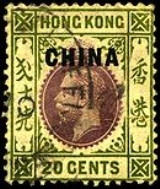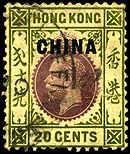
British post offices in China
Encyclopedia
The British post offices in China were a system of post office
s set up by the United Kingdom
in various treaty ports of China
in the late 19th and early 20th centuries.
 As a consequence of the Treaty of Nanking
As a consequence of the Treaty of Nanking
of 29 August 1842, Great Britain opened five consular postal agencies on 16 April 1844. Another five were opened later.
Initially letters were simply bagged in these cities and carried to Hong Kong
, where they were cancelled "B62"; later (1860s/70s) each office received its own postmarking devices.
Postage stamp
s of Hong Kong were used from 1862 on, but after 1 January 1917 the Hong Kong stamps were overprint
ed "CHINA". The initial overprinting including 16 values ranging from 1 cent to 10 dollars; from 1922 on, an additional 10 values with the Multiple Script CA watermark were also overprinted.
All of the offices were closed on 30 November 1922.
The settlement at Wei-Hai-Wei was a leasehold rather than a treaty port. It was occupied on 24 May 1898, and mail franked with the Wei-Hai-Wei local was carried to Chefoo by Cornébé and Co. for onward processing. This lasted until the Chinese Liu Kung Tau Post Office was opened in March 1899, and it was in turn replaced by a British post office on 1 September 1899. A second British Post Office was opened at Port Edward in 1904. Hong Kong stamps overprinted "CHINA" continued in use in both offices until the settlement was given up on 1 October 1930.
Post office
A post office is a facility forming part of a postal system for the posting, receipt, sorting, handling, transmission or delivery of mail.Post offices offer mail-related services such as post office boxes, postage and packaging supplies...
s set up by the United Kingdom
United Kingdom
The United Kingdom of Great Britain and Northern IrelandIn the United Kingdom and Dependencies, other languages have been officially recognised as legitimate autochthonous languages under the European Charter for Regional or Minority Languages...
in various treaty ports of China
China
Chinese civilization may refer to:* China for more general discussion of the country.* Chinese culture* Greater China, the transnational community of ethnic Chinese.* History of China* Sinosphere, the area historically affected by Chinese culture...
in the late 19th and early 20th centuries.

Treaty of Nanking
The Treaty of Nanking was signed on 29 August 1842 to mark the end of the First Opium War between the United Kingdom of Great Britain and Ireland and the Qing Dynasty of China...
of 29 August 1842, Great Britain opened five consular postal agencies on 16 April 1844. Another five were opened later.
- AmoyAmoyXiamen, or Amoy, is a city on the southeast coast of China.Amoy may also refer to:*Amoy dialect, a dialect of the Hokkien lects, which are part of the Southern Min group of Chinese languages...
(1844), Cancelled "A1" 1866-1885; "D27" from 1876-1885 - Canton (1844), Cancelled "C1" 1866-1885
- Foochow (1844), Cancelled "F1" 1866-1885
- Ningpo (1844), Cancelled "N1" 1866-1885
- ShanghaiShanghaiShanghai is the largest city by population in China and the largest city proper in the world. It is one of the four province-level municipalities in the People's Republic of China, with a total population of over 23 million as of 2010...
(1844), Cancelled "S1" 1866-1885 - Swatow (1861), Cancelled "S2" 1866-1885
- Hankow (1872), Cancelled "D29" 1879-1885
- Kiungchow (1873), Cancelled "D28" 1876-1885
- Tientsin (1882)
- Chefoo (1903)
Initially letters were simply bagged in these cities and carried to Hong Kong
Hong Kong
Hong Kong is one of two Special Administrative Regions of the People's Republic of China , the other being Macau. A city-state situated on China's south coast and enclosed by the Pearl River Delta and South China Sea, it is renowned for its expansive skyline and deep natural harbour...
, where they were cancelled "B62"; later (1860s/70s) each office received its own postmarking devices.
Postage stamp
Postage stamp
A postage stamp is a small piece of paper that is purchased and displayed on an item of mail as evidence of payment of postage. Typically, stamps are made from special paper, with a national designation and denomination on the face, and a gum adhesive on the reverse side...
s of Hong Kong were used from 1862 on, but after 1 January 1917 the Hong Kong stamps were overprint
Overprint
An overprint is an additional layer of text or graphics added to the face of a postage stamp or banknote after it has been printed. Post offices most often use overprints for internal administrative purposes such as accounting but they are also employed in public mail...
ed "CHINA". The initial overprinting including 16 values ranging from 1 cent to 10 dollars; from 1922 on, an additional 10 values with the Multiple Script CA watermark were also overprinted.
All of the offices were closed on 30 November 1922.
The settlement at Wei-Hai-Wei was a leasehold rather than a treaty port. It was occupied on 24 May 1898, and mail franked with the Wei-Hai-Wei local was carried to Chefoo by Cornébé and Co. for onward processing. This lasted until the Chinese Liu Kung Tau Post Office was opened in March 1899, and it was in turn replaced by a British post office on 1 September 1899. A second British Post Office was opened at Port Edward in 1904. Hong Kong stamps overprinted "CHINA" continued in use in both offices until the settlement was given up on 1 October 1930.
Sources
- Stanley Gibbons Ltd: various catalogues
- Robson LoweRobson LoweJohn Harry Robson Lowe , Robbie to his friends, was an English professional philatelist, stamp dealer and stamp auctioneer.- Life and career :...
, The Encyclopedia of British Empire Postage Stamps, Vol. 3, Pt. 3, London, Robson Lowe Ltd., 1949. Reprinted as Volume 40 of Billig's Philatelic Handbook, pp.468-477. - Encyclopaedia of Postal History
- Wellsted, RossiterStuart RossiterPercival "Stuart" Bryce Rossiter was a renowned British philatelist and postal historian who wrote extensively about British postal history and postage stamps of British colonies in Africa and was actively involved in numerous philatelic institutions...
, and Flower, The Stamp Atlas (Facts on File, 1986), pp. 257-258

